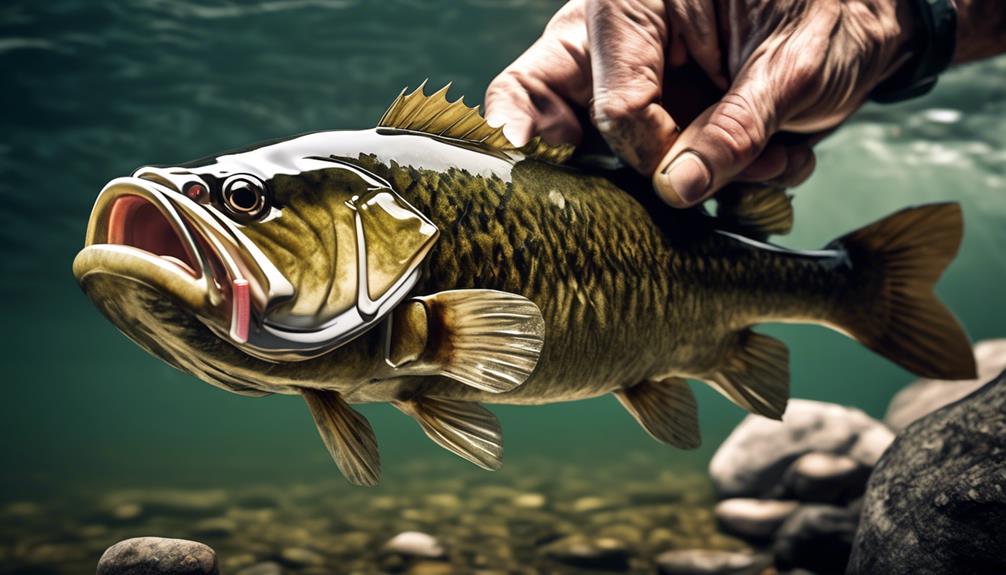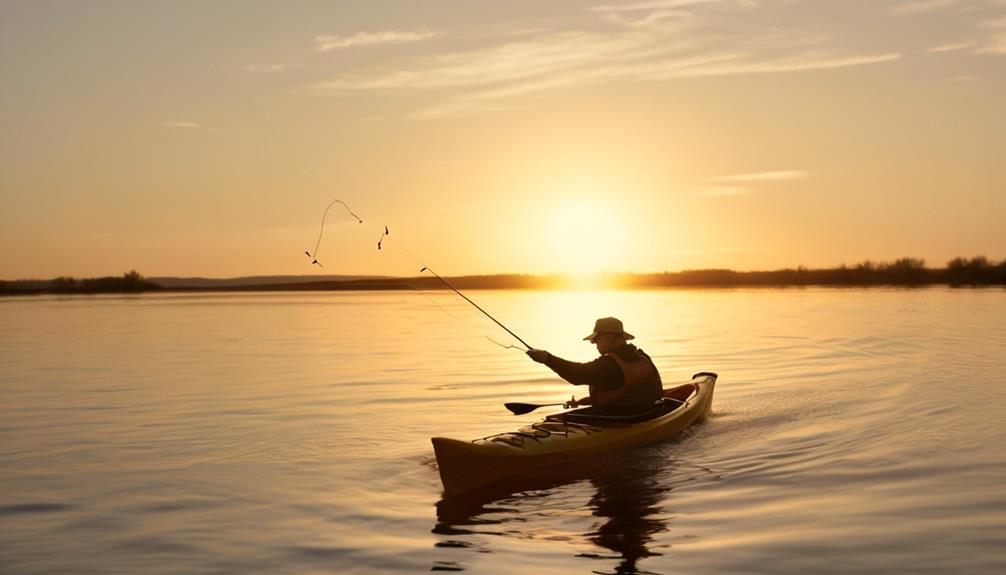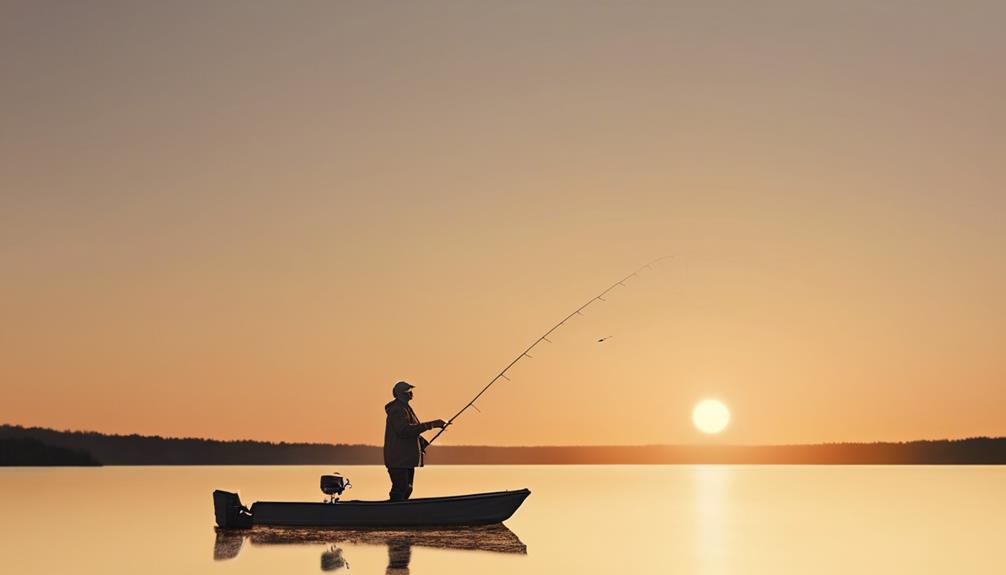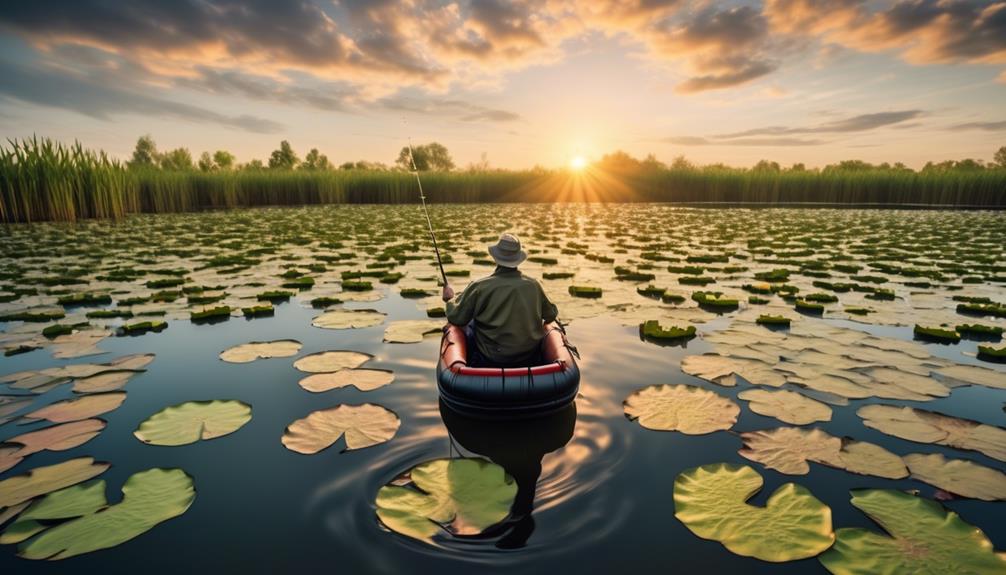You're out on the water, the sun is shining, and you've just spotted a prime location for smallmouth bass. You've got your kayak all set up and your gear ready to go.
But how do you ensure a successful catch? There are several key techniques that can make all the difference when it comes to reeling in those elusive smallmouth bass.
Whether it's choosing the right bait or mastering the perfect cast, having the right skills and knowledge can significantly improve your chances of success.
Choosing the Right Bait
When targeting smallmouth bass while kayak fishing, you'll want to choose the right bait to maximize your chances of a successful catch. Bait selection plays a crucial role in enticing smallmouth bass to strike. For smallmouth bass, soft plastic lures like crawfish imitations, tube baits, and creature baits are excellent choices. These lures mimic the natural prey of smallmouth bass, making them more likely to strike.
Additionally, consider using lures with natural colors like green pumpkin, watermelon, or brown to imitate the appearance of their natural forage. When presenting your bait, it's essential to understand the behavior of smallmouth bass. They often feed near the bottom, so a slow and steady presentation, bouncing the bait off the bottom, can be highly effective.
Lure color and size are crucial factors in bait selection. In clear water, opt for natural and translucent colors to mimic the appearance of the smallmouth bass's prey. In contrast, in murky water or low light conditions, brighter and bolder colors can be more visible and attractive to the fish.
When it comes to lure size, smaller baits are often preferred, especially in bodies of water where smallmouth bass are feeding on smaller prey. However, in certain situations such as when imitating larger prey or during spawning season, larger lures can also be effective.
Locating Smallmouth Bass Habitats
To locate smallmouth bass habitats, focus on identifying rocky areas, submerged structures, and deep pools where these fish are likely to seek shelter and forage for prey. Smallmouth bass are often found near rocky areas, as these provide them with shelter and protection. Look for areas with large rocks, boulders, and rocky shorelines, as these are prime smallmouth bass habitats.
Submerged structures such as fallen trees, brush piles, and underwater rock formations also attract smallmouth bass, providing them with cover and ambush points for hunting. Additionally, deep pools in rivers or lakes serve as resting and feeding areas for smallmouth bass, especially during hot weather or when water levels are low.
When scouting for smallmouth bass habitats, keep in mind the following tips:
- Spotting underwater structures: Look for signs of submerged structures such as shadows, changes in water movement, or distinct underwater shapes. These areas often harbor smallmouth bass.
- Identifying feeding patterns: Pay attention to the presence of baitfish, insects, or other prey species. Smallmouth bass are likely to be nearby, as they're opportunistic feeders and often follow their prey.
Perfecting the Cast
To achieve accurate and efficient casting while kayak fishing for smallmouth bass, focus on mastering your technique and timing to ensure your bait lands precisely where the fish are lurking.
Improving accuracy in your casting is essential for enticing those elusive bass. Start by adjusting your casting distance to match the location of the smallmouth bass. If they're holding near the shore or in shallow waters, a shorter cast may be all that's needed. On the other hand, if the bass are lurking further out or in deeper waters, you'll need to adjust your casting distance accordingly.
When it comes to improving accuracy, pay attention to your body positioning. Position yourself so that your casting shoulder is facing the direction you want to cast. This will help you achieve better accuracy and control over your cast. Another crucial factor in perfecting your cast is timing. Time your release so that the lure travels in the direction of the smallmouth bass habitat. This requires practice and patience, but mastering the timing of your cast can significantly improve your chances of a successful catch.
Furthermore, consider the wind direction and strength when adjusting your casting distance. A strong headwind will require a more forceful cast, while a tailwind may allow you to cast with less effort. By making these adjustments, you can ensure that your bait lands where the smallmouth bass are, increasing your chances of a successful catch.
Mastering the Retrieve
You can enhance your kayak fishing experience for smallmouth bass by mastering the retrieve technique, ensuring a smooth and enticing movement of your bait to attract the attention of the elusive bass. Mastering the retrieve is crucial for enticing smallmouth bass to strike.
Here are a few tips to help you improve your retrieve technique:
- Improving Accuracy: Focus on casting your bait close to underwater structures, such as rock formations, submerged logs, or weed beds, where smallmouth bass tend to hide. By accurately targeting these areas, you increase your chances of attracting a bite and landing a catch.
- Adjusting Speed: Experiment with varying retrieval speeds to determine what entices the smallmouth bass in your fishing spot. Sometimes a slow, steady retrieve can be effective, while at other times, a faster, erratic retrieve may trigger a strike. Observing the behavior of the bass and adjusting your retrieve speed accordingly can make a significant difference in your success rate.
- Using Jerkbaits and Crankbaits: Incorporating jerkbaits and crankbaits into your retrieve can mimic the erratic movements of wounded baitfish, making them irresistible to smallmouth bass. Utilize sharp twitches and pauses in your retrieve to imitate injured prey, prompting aggressive strikes from nearby bass.
Mastering the retrieve technique is an ongoing process that involves honing your skills through practice and adaptation to the behavior of smallmouth bass in different conditions. By improving your accuracy and adjusting your retrieval speed, you can significantly enhance your chances of a successful kayak fishing expedition for smallmouth bass.
Understanding Smallmouth Bass Behavior
Understanding the behavior of smallmouth bass is essential for improving your kayak fishing success and effectively targeting this species in various water conditions.
Smallmouth bass are known for their aggressive feeding habits, especially during low-light periods such as dawn and dusk. They're opportunistic feeders and often lurk near structures like rocks, logs, and weed beds, waiting to ambush their prey.
When targeting smallmouth bass, it's crucial to focus your efforts around these areas and adjust your fishing techniques to mimic the natural movement of their prey. Additionally, understanding the seasonal patterns of smallmouth bass feeding can significantly enhance your chances of a successful fishing trip.
During the warmer months, smallmouth bass tend to feed more actively, while in colder water, they may be less aggressive and prefer slower presentations.
In terms of breeding behavior, smallmouth bass typically spawn in late spring to early summer when water temperatures range from 60 to 70 degrees Fahrenheit. During this period, they move to shallow rocky areas to build nests and spawn. It's important for anglers to be mindful of these nesting areas and practice catch-and-release during the spawning season to help maintain healthy bass populations.
Maneuvering the Kayak for Better Positioning
Maneuver your kayak to position yourself near structures like rocks, logs, and weed beds, where smallmouth bass often lurk to ambush their prey. Proper positioning is crucial for maximizing your chances of catching these elusive fish. To achieve optimal positioning, consider the following paddle techniques and positioning strategies:
- Sweep Stroke: Use the sweep stroke to turn your kayak efficiently. This stroke involves extending your paddle out to the side of the kayak and then sweeping it in a wide arc. This allows you to pivot your kayak quickly, enabling you to navigate around obstacles and position yourself precisely near potential bass hideouts.
- Anchoring: Utilize an anchor to maintain your position near prime fishing spots. Once you've located a promising area, drop the anchor to stabilize your kayak. This prevents the current or wind from pushing you away, ensuring you can focus on your fishing without constantly paddling to maintain your position.
- Back-Paddling: Master the skill of back-paddling to fine-tune your positioning. By paddling in reverse, you can carefully maneuver your kayak away from obstacles or adjust your distance from a structure. This technique is especially useful when you need to retreat from a potential snag without disturbing the surrounding water too much.
Techniques for Handling Smallmouth Bass

When handling smallmouth bass, it's important to use proper techniques to ensure the fish's well-being and your own safety. First and foremost, always wet your hands before handling the fish. This helps protect their delicate skin and scales. Avoid using towels or dry hands as they can remove the fish's protective slime layer, which can make them more susceptible to diseases.
When lifting the bass, support its body properly to avoid injuring its internal organs. Cradle the fish gently with one hand supporting the belly and the other hand supporting the tail. Avoid putting excessive pressure on the fish's body to prevent injury.
It's also crucial to minimize the time the fish spends out of the water. If you're practicing catch and release, quickly unhook the fish and release it back into the water. The longer the bass is out of its natural environment, the more stressed it becomes, which can decrease its chances of survival after being released.
Additionally, avoid holding the fish by its gills or eyes, as this can cause serious harm. Always handle the fish with care and respect, ensuring its well-being even after it's been caught.
Safety Tips for Kayak Fishing
To ensure your own safety while kayak fishing for smallmouth bass, it's important to be mindful of proper handling techniques, transitioning now to safety tips specific to kayak fishing. When out on the water, safety should always be a top priority. Here are some essential safety tips to keep in mind:
- Paddle Safety: Always wear a personal flotation device (PFD) when kayak fishing. Additionally, ensure that your paddle is securely attached to your kayak to prevent it from getting lost if you capsize. Familiarize yourself with basic paddle techniques and practice them in calm waters before attempting more challenging conditions.
- Emergency Preparedness: It's crucial to be prepared for unexpected situations. Pack essential safety gear such as a first aid kit, a whistle, and a communication device in a dry bag. Familiarize yourself with basic rescue techniques and know how to re-enter your kayak from the water in case of a capsize. It's also advisable to check weather conditions before heading out and to inform someone of your planned route and estimated return time.
- Water Awareness: Stay informed about the water body you'll be kayaking in. Be aware of any potential hazards, such as strong currents, submerged obstacles, or changing weather conditions. Keep an eye on your surroundings and be mindful of other watercraft to avoid collisions.
Frequently Asked Questions
How Do Weather Conditions and Water Temperature Affect Smallmouth Bass Behavior and Fishing Techniques?
When weather patterns change and water temperature fluctuates, Smallmouth Bass behavior shifts, affecting your fishing techniques. Pay attention to these factors and adapt your approach accordingly to maximize your chances of landing a catch.
What Are Some Common Mistakes Kayak Anglers Make When Targeting Smallmouth Bass?
When targeting smallmouth bass from a kayak, common mistakes include not using proper gear, ignoring technique adjustments, and overlooking weather patterns. Avoid these slip-ups to enhance your fishing success and make the most of your kayak angling experience.
Are There Any Specific Kayak Modifications or Gear Recommendations for Smallmouth Bass Fishing?
For kayak modifications, consider adding a fish finder or anchor trolley. Gear recommendations include a light spinning rod, crankbait, and soft plastic lures. These will help you target smallmouth bass more effectively from your kayak.
Can You Provide Tips for Fishing for Smallmouth Bass in Different Seasons (Spring, Summer, Fall, Winter)?
In different seasons, smallmouth bass habitat changes. Use different baits for each season to catch them. In spring, try using crawfish or jerkbaits. In summer, topwater lures work well. In fall, try crankbaits. In winter, use jigs.
What Are Some Effective Strategies for Fishing for Smallmouth Bass in Rivers and Streams From a Kayak?
When fishing for smallmouth bass in rivers and streams from a kayak, position your kayak strategically, select the right bait, consider the river current, and approach stealthily. These techniques increase your chances of a successful catch.
Conclusion
So there you have it, the top kayak fishing techniques for smallmouth bass.
By choosing the right bait, locating their habitats, perfecting your cast, mastering the retrieve, understanding their behavior, maneuvering your kayak for better positioning, and handling them with care, you'll be well on your way to a successful fishing trip.
Just remember to prioritize safety and always be mindful of your surroundings while out on the water.
Happy fishing!



